
WHAT TO WATCH
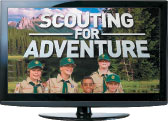 The Boys Are Back!
The Boys Are Back!
Don’t miss the second season of “Scouting For Adventure,” the Outdoor Channel’s original series based on the BSA and Boys’ Life. Filmed at national high adventure bases and Scout camps across the United States, the series highlights exciting activities: rock climbing, kayaking, scuba diving, backpacking, horse riding, canoeing, whitewater rafting.
You’ll see plenty of scenic beauty as Scouts tackle challenging outdoor activities such as coral-reef sailing and mountain trekking, but the emphasis remains on Scouting’s core values, safety, and team building.
The season is already under way. Each of September’s four episodes runs four times, so tune in Wednesdays at 8:30 a.m. Saturdays at 1:30 and 6:30 p.m., or Sundays at 6 a.m. (all times Eastern). Or, set the DVR.
 Tune in to
‘America’s
Best Idea’
Tune in to
‘America’s
Best Idea’
Yosemite. Yellowstone. The Everglades. Gates of the Arctic. The names read like an honor roll of America’s great national parks. And starting this month, Ken Burns, one of America’s great documentary filmmakers, takes viewers inside these parks as they’ve never been seen before with “The National Parks: America’s Best Idea.”
Filmed over the course of more than six years in some of the country’s most spectacular locales, Burns’ 12-hour, six-part series tells the story of the parks and the people—rich and poor, famous and unknown, soldiers and scientists, natives and newcomers, idealists, artists, and entrepreneurs—who devoted themselves to saving some precious portion of the land they loved.
“The National Parks: America’s Best Idea” runs each night between Sept. 27 and Oct. 2. All episodes will be shown more than once; check local listings for times.
 Scouting Goes green
Scouting Goes green
From the forest to the pressroom to the mailboxes of 1 million subscribers five times a year, Scouting adheres to a strict policy of environmental responsibility. That tradition was recognized recently by the Sustainable Forestry Initiative (SFI), which certified Scouting magazine—and Boys’ Life, too.
SFI’s seal of approval means that the Scouting workflow at its printing partner, Quad/Graphics, will undergo annual surveillance audits as well as full certification against the SFI Standard every five years.
With more than 154 million acres certified across North America, the SFI sustainable forestry certification program is one of the largest in the world. Partners like SFI will help Scouting and its readers continue to be good stewards of the earth.
 Got Photos?
Got Photos?
Send them to us and you might be a winner in Scouting magazine’s Celebrate the Adventure Photo Contest. We must receive your entries by Oct. 1.
Go to www.scoutingmagazine.org/photocontest, for all rules and more information.
Help wanted for sizzling summer fun
If you’re a Scout or Scouter 18 or older who loves the outdoors, learns fast, and enjoys working with people, the BSA’s three high adventure bases invite you to apply for a super summer job. Here’s how to make contact:
Florida National High Adventure Sea Base
Summer hires: 130.
Pays: $215 per week and up, more for specialty positions. Room and board are also provided.
Positions include program, retail, and food services staff. Specialized positions, such as scuba instructors and watercraft operators, must be certified prior to employment.
P.O. Drawer 1906, Islamorada, FL 33036; www.bsaseabase.org.
Philmont Scout Ranch
Summer hires: 1,000.
Pays: $950 a month, plus room and board.
Positions include trek rangers, backcountry interpreters, and craft counselors.
17 Deer Run Road, Cimarron, NM 87714;
575-376-2281, philstaff@philmontscoutranch.org.
Northern Tier National High Adventure Bases
Summer hires: 175.
Positions include canoe trip leaders and outfitting staff. Pay varies by position; first-year staffers generally make $920 a month, plus room and board.
P.O. Box 509, Ely, MN 55731-0509:
218-365-4811, info@ntier.org.
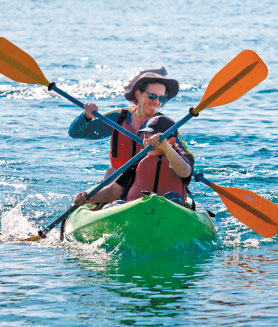 SAVING OUR WATERY WORLD
SAVING OUR WATERY WORLD
Whether they’re swimming, kayaking, or scuba diving, Scouts take to water, well, like a duck takes to water. That’s all the more reason to help honor the 100th anniversary of the BSA by signing up for the Preserve America’s Waterways Initiative. The program challenges participants to give 1 million community service hours this year to help preserve and protect our nation’s lakes, streams, rivers, and shorelines.
There’s no one formula for getting involved with the initiative. Depending on their home base, some Scouts and Scouters might restore local watersheds or monitor water quality, while others could clean up beaches or work to restore coral reefs.
Jimmie Homburg, chairman of the Preserve America’s Waterways Project, says the benefits can be enormous both for the environment and the Scouts and leaders who pitch in to help.
“It’s our world, and we have a chance to leave it to the next generation better than we found it,” Homburg says. “Your efforts will set an example for the entire nation.”
To make a splash in this vital project, go to www.pawaterways.org.
Countdown to 100
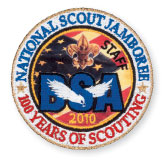 The 2010 National Scout Jamboree celebrates 100 years of Scouting, and you can play a key role in the festivities as a member of the jamboree staff.
The 2010 National Scout Jamboree celebrates 100 years of Scouting, and you can play a key role in the festivities as a member of the jamboree staff.
Scheduled for July 26-Aug. 4 at Fort A.P. Hill in Virginia, the jamboree needs staff applicants born between July 27, 1984, and July 26, 1994, to serve in a variety of capacities.
The staff fee for persons 16 to 25 years old is $397.50. That’s half the price of the staff fee ($795) for applicants age 26 and older.
To apply and get more information about jamboree staff qualifications, available positions, and clearance procedures, go to www.bsajamboree.org.
Tour Permits Now Online
Registered unit leaders can save time and paper by submitting local and national tour permit applications online. From MyScouting at www.scouting.org, go to Tour Permits and enter the necessary information for the tour. Helpful messages will guide you through the process. You’ll also see any specific rules for tour permits. The new system will save transportation and training information so it won’t have to be re-entered for future applications.
Remember, local tour permit applications (for trips of less than 500 miles) must be submitted two weeks before the tour start date. National applications (for trips of more than 500 miles) must be submitted at least one month before the tour start date.
Way Back When
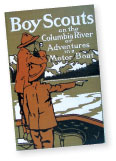 One for the Books
One for the Books
The BSA doesn’t have an official author, but one candidate for the job might be G. Harvey Ralphson (1879-1940), an American Scoutmaster who wrote more than a dozen novels featuring Boy Scouts saving the day in America and around the globe. Ralphson’s titles include Boy Scouts in the Canal Zone (1911), The Boy Scouts Beyond the Arctic Circle (1913), and The Boy Scouts on the Open Plains (1914).
Ralphson hoped that his novels would help boys and girls “grow in usefulness, self-reliance, patriotism, and unselfishness.” You can read excerpts from some of his books at www.online-literature.com/ralphson. Click on a book title at left, and a list of chapters will appear.
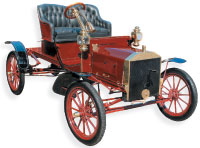 Waite’s Wheels
Waite’s Wheels
A brand-new car for $500? Yep. That was the price tag on Henry Ford’s 1906 Model “N,” which weighed only 800 pounds and ran the roads at a cool 40 miles per hour, an eye-popping speed in those days.
If you visit Philmont, check out a fully restored Model “N” that was purchased by Waite Phillips back in the 1920s. Chuck Walneck, a member of the Philmont Ranch Committee, spent a year restoring the car with the help of some of the finest automotive craftsmen in the country.
Now if we could only dial gas prices back to 1906 levels.
 |
Keep on Truckin'
Shift your celebration of the BSA’s 100th anniversary into overdrive with a visit to “Adventure Base 100” when it rumbles to a location near you during 2010.
Starting immediately after its debut Jan. 1-3 at the Tournament of Roses festivities in Pasadena, Calif., this 18-wheeler hauling a fascinating interactive exhibit will hit the road to more than 40 destinations throughout the continental United States. Millions of families like yours can connect with the breadth of the Scouting experience.
What will you see and do? Plenty. And you won’t miss the mammoth truck if you spot it on the highway. You’ll recognize it by the scenes of Scouts in action, as well as by the anniversary logo and legend writ large on the side: “100 Years of Scouting: Celebrating the Adventure, Continuing the Journey.”
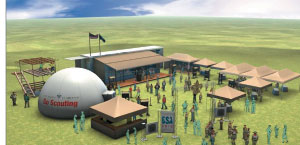 Don’t miss the virtual Adventure Base 100 tour, either. Keep up with all developments and find out where you can see this motor-vating exhibit in your area at the BSA’s 100th anniversary Web site: www.scouting.org/100 years.
Don’t miss the virtual Adventure Base 100 tour, either. Keep up with all developments and find out where you can see this motor-vating exhibit in your area at the BSA’s 100th anniversary Web site: www.scouting.org/100 years.
STRUCTURES AND ACTIVITIES
Traveling Lodge—a double-wide trailer that offers guests a stage for Scouting demonstrations and a traveling museum, with more than 1,000 square feet of multisensory Scout-related experiences.
Go Scouting Dome—surround-sound, surround-vision immersion chamber that features a multitude of typical Scouting environments.
Ropes Course and Zip Line—exciting, outdoor fun.
Green Screen—picture yourself doing cool Scouting activities.
Guest Tents—informative sites where boys and adults can learn about joining the BSA, everyone can purchase Scouting memorabilia and patches, and sponsors can promote their partnership with the organization.
2010 TOUR SCHEDULE
Jan. 1-3: Pasadena, Calif. |
June 11-13: Chattanooga, Tenn. |
 GOTTA HAVE IT: THE ULTIMATE GADGET
GOTTA HAVE IT: THE ULTIMATE GADGET
Here’s a multidimensional jewel that will work wonders on camp-outs and Scout projects of all kinds. The new Super Tool 300 from Leatherman ($84) comes with more pop-out features than we can list, but try pliers, removable wire cutters, saw, screwdrivers, bottle opener, can opener, and serrated knife for starters. It even includes an added smart touch called “edge-safety clumping,” which prevents users from accidentally pulling out one of the knives and getting cut when trying to access a different tool. You’ll want to add this baby to your troop or crew’s toolbox.
Good Read: You Will Survive
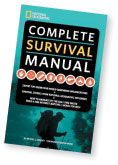 Do you know how to avoid “woods shock,” self-arrest with an ice ax, and test to see if an unknown plant is edible?
Do you know how to avoid “woods shock,” self-arrest with an ice ax, and test to see if an unknown plant is edible?
You can master all that and discover hundreds more tips for staying safe in the outdoors from the National Geographic Complete Survival Manual (National Geographic Books, $29.95). Loaded with expert advice from the editors of National Geographic (along with valuable tips from the BSA, Girl Scouts of the USA, American Red Cross, and the U.S. Army), the book shows readers how to survive and thrive on rough seas, in steamy swamps, or on polar ice.
The survival manual teems with information laid out in a logical, easy-to-find structure. Each chapter is split into 10 subheads, including First Aid, Food, Shelter, and Signaling. Pack it along and be ready for just about any curve nature can throw.
In Memoriam: Edward Whitehead
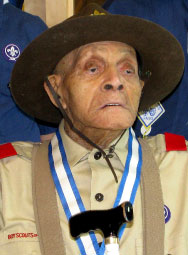 Edward Whitehead, the Detroit Area Council’s oldest Scout, passed away in July in Detroit at the age of 102. As a boy, Whitehead had a good excuse for never being a Cub Scout. The Cub Scouts didn’t exist when he joined Troop 113 in Albion, Mich., in 1922. He was associated with Scouting for the rest of his life, as a Cubmaster, Scoutmaster, unit commissioner, camporee staffer, and more. At 86, Whitehead began serving on the summer camp staff of the Detroit Area Council, which recently honored his long service at a banquet.
Edward Whitehead, the Detroit Area Council’s oldest Scout, passed away in July in Detroit at the age of 102. As a boy, Whitehead had a good excuse for never being a Cub Scout. The Cub Scouts didn’t exist when he joined Troop 113 in Albion, Mich., in 1922. He was associated with Scouting for the rest of his life, as a Cubmaster, Scoutmaster, unit commissioner, camporee staffer, and more. At 86, Whitehead began serving on the summer camp staff of the Detroit Area Council, which recently honored his long service at a banquet.
Whitehead sometimes hiked farther and worked longer hours than some of the teenage camp staff. He attributed his longevity to his continued work on behalf of young people—and the fact that he never missed a winter camp-out.
LOL! But he's only a Third Cousin
 Last summer at camp, I got the wonderful task of teaching fishing to Cub Scouts. To enforce the catch-and-release policy, I pretended to know the names of all the catfish we caught. The boys thought it was fun to catch “Ugly,” “Uglyette,” “Simon,” “Snorkel,” and “Big Boy.”
Last summer at camp, I got the wonderful task of teaching fishing to Cub Scouts. To enforce the catch-and-release policy, I pretended to know the names of all the catfish we caught. The boys thought it was fun to catch “Ugly,” “Uglyette,” “Simon,” “Snorkel,” and “Big Boy.”
After camp ended, I was in the grocery store when a Cub Scout came over and hugged me. But when he began to make faces about what was in my shopping cart, I asked him “What’s wrong?”
He replied, “Does Ugly know you’re eating his cousin for dinner?”
-- Summer Pearson, Riverside, Calif.
Do you have a Laugh-Out-Loud Scouting anecdote?
Write it up in 150 words or less and submit it to LOL at www.scoutingmagazine.org. If we print it, we’ll pay you $50.
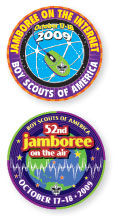 Air it out
Air it out
Experience the thrill of sharing your adventures with Scouting peers during the 52nd Jamboree-on-the-Air (JOTA) and 13th Jamboree-on-the-Internet (JOTI) taking place Oct. 17-18.
Sponsored by the World Organization of the Scout Movement, both of these special editions feature a “green” theme: “Climate Change Challenge (C3).”
As usual, your kids can make contact with Scouts and Guides from more than 150 countries via shortwave radio and personal computers. But this year they’ll also help showcase Scouting’s ongoing efforts to protect the environment and battle climate change.
Check with your council or district for local venues and get all the details to register and participate at
www.scouting.org/international/highlights.
THIS OLD PATCH: Journey through time (and trees)
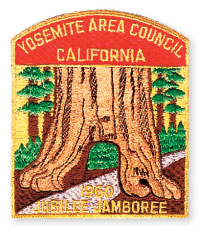 Excited about the National Scout Jamboree in 2010? That feeling must at least equal the anticipation your predecessors felt 50 years ago.
Excited about the National Scout Jamboree in 2010? That feeling must at least equal the anticipation your predecessors felt 50 years ago.
In 1960, the Golden Jubilee jamboree celebrated a milestone in BSA history—50 years of Scouting. More than 55,000 Scouts and Scouters showed up for that one, the only jamboree to take place in Colorado Springs, Colo. And members of the Yosemite Area Council wore the patch you see at right.
You might recognize its most-prominent element—if you happened to visit Yosemite Park prior to 1969: The Wawona Tree.
Before it fell that year under the weight of a big load of snow, this giant sequoia served as a popular tourist attraction. Visitors could drive their cars right through its massive trunk.
But can you spot the other defunct element of the patch? The Yosemite Area Council no longer exits, either. In the late 1990s, it merged with the 49er Council to form the Greater Yosemite Council.
If you can get your hands on one of these, you’ve got quite a collector’s item.